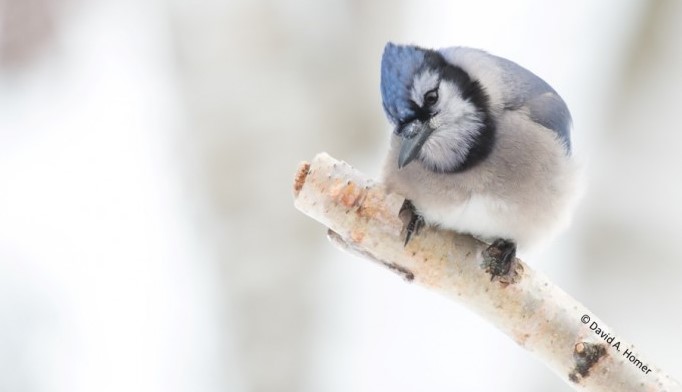When I first wrote about Blue Jays back in 2012, concentration was on their darker, meaner, rogue side as members of the Corvid family of birds which also includes Crows and Ravens; how they steal eggs and young of other birds to feed their own young and how they bully any other bird or animal in the playground!
This column is different as I want you to know how very much I really appreciate these noisy, boisterous, bombastic bullies, in spite of having characteristics which remind me of one of the U.S. Republican presidential hopefuls. These birds however need not resort to dying their feathers blond because in their natural state, they are already handsomely dressed and quaffed.
Hated by songbirds all spring and summer, as nest robbers, they garner a healthy respect from the smaller birds at winter feeders. Blue Jays are usually the first bird to announce the threat posed by incoming hawks and owls
This fall and now into winter, Blue Jays, along with the trusted Chickadees have been the most plentiful visitors to our feeders. Because they are bigger and therefore much easier to observe, we have had the pleasure to have watched them very closely this year, and they have performed admirably for us. They are real characters! While at the feeder, they do not realize it, but they are tremendous models for photographers as they bob, weave, strut and bully anyone wishing to join them at the table!
Few birds will approach the feeders as they do with little hesitation as they don’t have much fear of other birds that may be at the feeder. Most other birds will scatter on the Jay’s arrival, with the exception of members of the woodpecker family which hold their ground. Once there, they begin to gorge themselves, filling their crop and mouth with sunflower seeds or peanuts. One of their favourite foods in fall are acorns from local oak trees. Once laden with as many seeds as they can carry, they may fly off a mile or more to cache the seeds and acorns in tree crevasses or in the ground for later use.
Research indicates that as many as 75% of the seeds are never later found by them (significantly less than Chickadees which recover up to 90% of their cashes). With only a small percent of the seeds they bury in the ground are consumed by them, Blue Jays are perhaps most responsible for the growth of millions of oak trees in their North American range.
If you have an oak hardwood floor in your home, it is quite likely that at least some of the planks were milled from trees which were planted many years ago by ancestors of that bird at your feeder this very moment!
Hated by songbirds all spring and summer, as nest robbers, they garner a healthy respect from the smaller birds at winter feeders. Blue Jays are usually the first bird to announce the threat posed by incoming hawks and owls with loud screams from top branches of naked trees, giving birds at the feeders time to scramble for cover.
Rascals they are, but they are a delight to have in our yard!
Written by David A. Homer.

